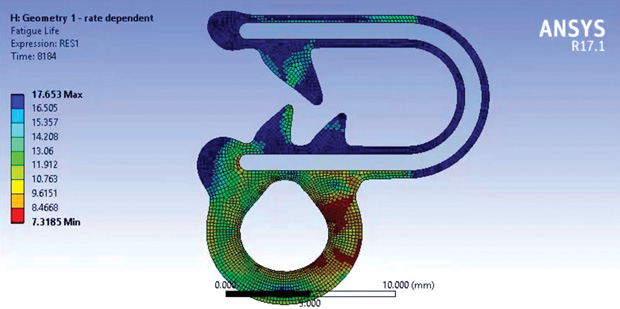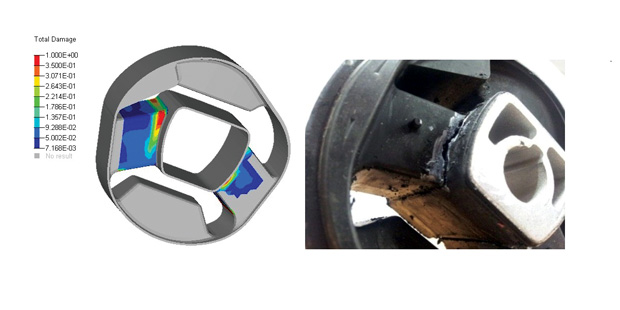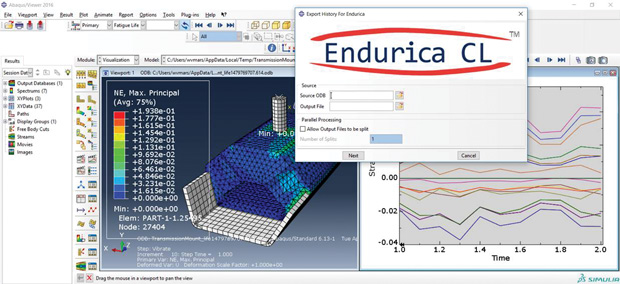
A rubber seal with contours of fatigue life resulting from a duty cycle, where the seal goes through open/close cycles. In this case, the predicted life is 21 million cycles, and failure is predicted to initiate at the red locations. Analysis done with ANSYS software. Image courtesy of ANSYS.
Latest News
January 3, 2017
Usually rock bands and music icons develop devoted fanbases, but can a rubber analysis class do that? Kurt Miller, president of Axel Products Inc., says his company’s training courses do.
 A rubber seal with contours of fatigue life resulting from a duty cycle, where the seal goes through open/close cycles. In this case, the predicted life is 21 million cycles, and failure is predicted to initiate at the red locations. Analysis done with ANSYS software. Image courtesy of ANSYS.
A rubber seal with contours of fatigue life resulting from a duty cycle, where the seal goes through open/close cycles. In this case, the predicted life is 21 million cycles, and failure is predicted to initiate at the red locations. Analysis done with ANSYS software. Image courtesy of ANSYS.“A few of these classes have taken on a cult-like following over the years,” he says. “We have cases where the attendee’s boss attends [a class], and then the boss’ boss attends it, and so on.”
Axel offers material testing services for engineers and analysts. It focuses on nonlinear materials such as elastomers and plastics for users of simulation software. The classes listed at Axel’s home page are usually labelled as “experimental:” ANSYS Mechanical Experimental Elastomers, [MSC Software’s] Marc Experimental Elastomer Analysis, and so on. The term deserves an explanation.
“By ‘experimental,’ we mean we work with the simulation software companies to create a training course that involves both physical experiments like tensile tests and shear tests, and we use the analysis software to generate descriptive material representations in the simulation software,” Miller says. “We turn real test data into realistic simulations. Attendees go into the lab and see the behaviors that the math describes.”
There are some things about rubber that might not be intuitive to those used to working with metal. So, observing the eccentric behaviors of the elastomers is a good way to develop the judgments that some engineers may lack.
Elastomer Eccentricities
Dr. Will Mars is a recognizable figure in the field of elastomer analysis. He won the 2007 Sparks Thomas award of ACS Rubber Division, and the 1999 Henry Fuchs award of Society of Automotive Engineers Fatigue Design & Evaluation committee. In 2008, Mars founded Endurica LLC. The company’s first software product was Endurica CL, described as the “original, full-featured, standalone solver built specifically for elastomer fatigue analysis.”
“People in the metals field have been using a technology called Critical Plane Analysis for two decades,” Mars explains, “This is an enabling technology that gives very accurate predictions of fatigue life when you have multiple load inputs and variable amplitude loading, as you do in real-world duty cycles. We were the first to implement it for elastomers. Our software allows you to model the impact of your part’s actual multiaxial, variable amplitude duty cycle on durability.”
Simulation software makers who do not have their own solvers for elastomers usually seek partnerships with specialists like Endurica. The Endurica solver is available as a plug-in to Dassault Systèmes’ fe-safe fatigue analysis software. The plug-in is called fe-safe/Rubber, and is distributed and supported by Dassault Systèmes. Endurica CL also integrates with ANSYS Workbench and can be added to many ANSYS Mechanical products, according to Richard Mitchell, lead product marketing manager for Structures at ANSYS.
The Endurica software comes with a preloaded library of elastomer materials, compiled from published scientific sources. Therefore, you can use it out-of-the-box by assigning an appropriate rubber type from the list to your digital model. But you can further refine your predictive model if you work with a testing lab to obtain accurate mathematical parameters relevant to your material.
Elastomer Physical Tests and Virtual Modeling
With metal, a single tensile test may serve as the foundation for virtual modeling, but not so with elastomers. “Nearly all elastomeric parts undergo complex, non-intuitive strain conditions,” Miller says. “We need to perform a set of experiments subjecting elastomers to a few different states of strain to understand how they will perform in service.”
In elastomers, the mechanics of failure is nearly always related to a crack growing event. “To predict fatigue in elastomeric parts, we need to study how cracks start and how cracks grow in elastomeric materials under various loadings and temperatures,” Miller says. “We also need to perform simulations where the orientation of stresses relative to crack surfaces is part of the fatigue calculation. This is sometimes referred to as critical plane analysis. Keep in mind that the stress field in elastomeric parts is very complex. It really isn’t obvious where bad things may happen.”
 In elastomers, crack propagation is the typical damage mechanism. Endurica CL software, shown here, is described as the “original, full-featured, standalone solver built specifically for elastomer fatigue analysis.” Image courtesy of Endurica LLC.
In elastomers, crack propagation is the typical damage mechanism. Endurica CL software, shown here, is described as the “original, full-featured, standalone solver built specifically for elastomer fatigue analysis.” Image courtesy of Endurica LLC.You can get a lot of information about your product’s performance in the field by analyzing the damage mechanics, says Ed Terrill, applied research fellow, ARDL (Akron Rubber Development Lab). ARDL caters especially to the rubber and plastic industries. “We’re very good at dissecting molded rubber goods,” he says. “We do a lot of failure analysis and long-term cycling test for product life prediction.”
Durability is the most time consuming to physically test, and it is therefore the most expensive, says Mars. “That is why virtual methods for fatigue analysis are needed,” he says.
It’s also tough to model. “Fatigue behavior is extremely sensitive to many variables, and it varies on a logarithmic scale,” ANSYS’ Mitchell says. “You are doing good if you can predict life to within a factor of two or three. This is occasionally discouraging to new users who may be accustomed to predicting stiffness to within 10%. But it helps to keep in perspective that the output is only as good as the input, and that we rarely have enough knowledge of, or control over, the material properties, load histories and part geometry in a given scenario to really justify tighter error limits.”
Advocates of digital prototyping believe that conducting destructive tests in pixels and polygons is much cheaper than doing it with full-size assemblies and physical mockups. When it comes to large structures and assemblies that are expensive to produce (for example, full-sized armored vehicles), or components that involve expensive tooling or molds to manufacture, the economics are certainly in favor of using software-based simulation and analysis. Yet, at the part and component level, the insights gained from physical testing is well-worth the nominal cost involved.
Stronger with Stretching
The properties that make rubber desirable in many applications also make the material difficult to simulate. “Rubber’s stress-strain curve is nonlinear elastic, and it exhibits a cyclic softening phenomenon known as the Mullins effect,” Mars points out. “The strength and fatigue properties of rubber depend strongly on temperature and rate. Sometimes in rubber, cracks can develop under long-term static loads due to creep or ozone attack.”
One of the most peculiar features of natural rubber is strain crystallization. According to the article Strain-Induced Crystallization and Mechanical Properties of Functionalized Graphene Sheet-Filled Natural Rubber in Journal of Polymer Science, March 2012: “Natural rubber (NR) is a remarkable material that, when crosslinked, can be stretched to strains over 700% without rupture. At these high strains, rubber becomes ‘self-reinforcing,’ that is, it microcrystallizes, and the mechanical properties increase.”The phenomenon makes natural rubber a more preferable material than the non-crystallizing synthetic rubber for manufacturing crack- and rupture-resistant products, for parts that operate under conditions that induce crystallinity. “When that happens, the fatigue life can go up by factors of a hundred or a thousand,” says Mars. “There’s no equivalent to this behavior in ceramics or metal.”
In most applications, rubber is compounded or mixed with various other ingredients. “Sometimes people use a gum rubber, but in most applications, you mix the rubber with fillers like carbon black, silica or clay,” Mars notes. “The quality of filler dispersion can govern the size of crack precursors in rubber’s microstructure, which strongly influences fatigue performance.”
You can also adjust the stiffness or softness in a rubber part by using more or less curative. Take a typical tire, for instance. If you cut open a tire, you might find eight or nine different rubber compounds, says Mars: the tread, the inner liner, the sidewall ... “They all have quite distinct stress-strain and fatigue properties,” he says.
With metal-based products, joints and fasteners present vulnerabilities. With rubber and elastomers, understanding the effects of adhesives may play an important role. “A lot of the molded rubber goods are laminates ... With hoses, belts and tires, we’re often asked to test the adhesion strength,” ARDL’s Terrill says. “Products like cellphones are put together with layers and layers of adhesives and polymers. They don’t use screws. So the adhesive has to hold everything in place and also act like a shock absorber.”
Cluster-Powered Examination
To simulate the effects of stress on a product throughout its expected lifespan, testing service providers usually use heavy rigs, conveyer belts and environment chambers to expose the part to different loads. “One way to accelerate the aging process is to do the testing at elevated temperatures, then plot the rate of decay as a function of temperature and extrapolate to lower temperatures for the expected lifespan,” Terrill says.
Software-based fatigue life simulation can be run on typical engineering workstations, but larger jobs may demand additional help from the cloud or clusters. “When you model a part’s fatigue cycle, your FEA job tends to get bigger—bigger files, longer run times,” Mars says. “It’s one thing to do an FEA to calculate stiffness. But modeling your duty cycle will involve a longer-running job with larger files.”
How much larger depends on the application, ANSYS’s Mitchell says. It can multiply job size “anywhere from 2x to 100x or more,” he says. “The Endurica software has features that let users manage analysis size. For example, the discretization of the critical plane search can be adjusted for faster calculation, or thresholding can be applied to skip detailed calculations in elements where the loads are too small to cause damage. You can do useful calculations on an engineering workstation, but of course a cluster lets you solve much larger problems in less time.”
With elastomers, physical tests and digital simulation are used to reinforce each other. The accurate material model obtained from coupon testing makes the subsequent digital simulation much more reliable. And the field sample tests may reveal unanticipated failure modes that could be used to improve the digital model for subsequent predictions.
“The most important thing is to get and test products from the field to determine how the properties of the materials change in real life,” Terrill says.
More Info
Subscribe to our FREE magazine, FREE email newsletters or both!
Latest News
About the Author
Kenneth Wong is Digital Engineering’s resident blogger and senior editor. Email him at [email protected] or share your thoughts on this article at digitaleng.news/facebook.
Follow DE






